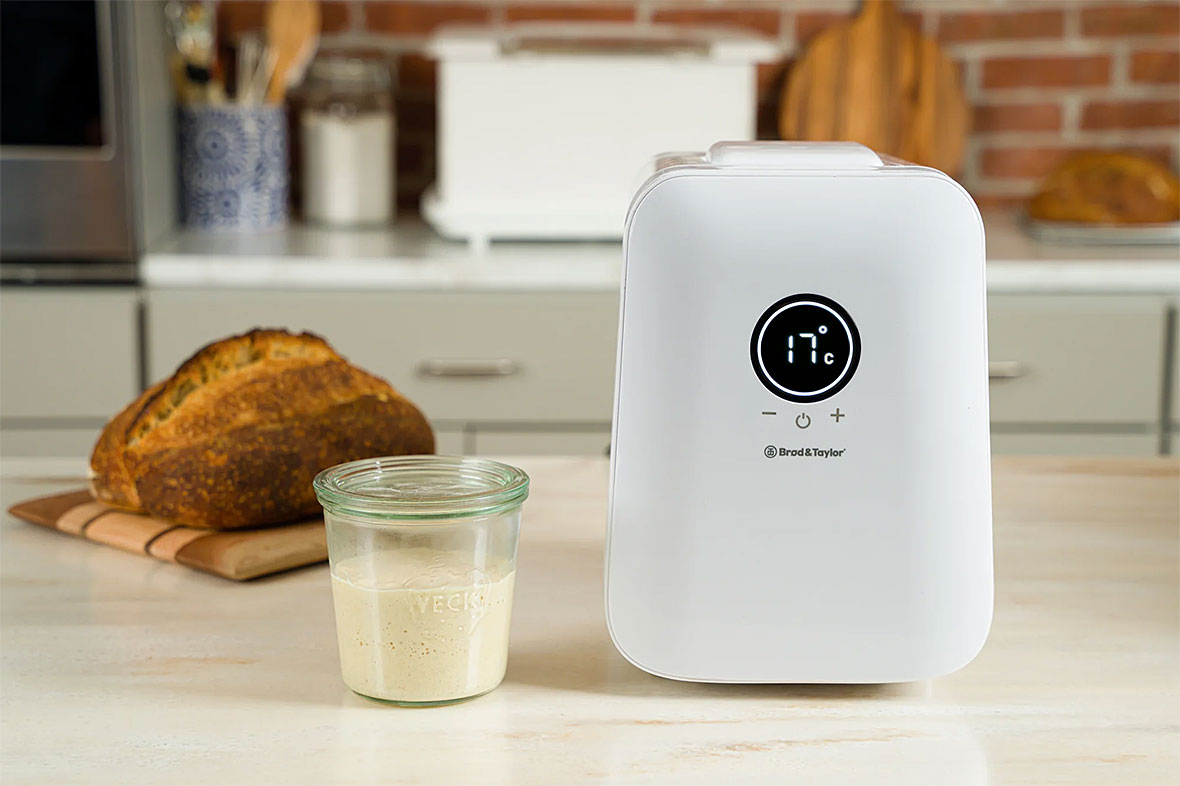Recipe and how-to for Pain au Chocolat
Pain au Chocolate, one of the most well-known French pastries, are a special treat you can enjoy any time of day. Flaky croissant dough is cut into rectangles rather than triangles and then wrapped around two chocolate batons. Fresh from the oven, the chocolate is still warm and melty, making this pastry a true joy to eat. Follow our detailed instructions below to make the best chocolate croissants.
How to make Chocolate Croissants
This recipe makes six chocolate croissants and is formulated to fit our 30 cm Dough Sheeter but can also be made with our 40 cm Dough Sheeter. Using a sheeter helps achieve a more even dough thickness and more precise layer, in addition to making the process easier and faster.
Read the recipe carefully, as timing and technique are important for the best outcome. Making chocolate croissants is a two-day process. The dough is mixed in the evening on the first day and then chilled overnight. The next day is when most of the work happens– the dough is laminated, shaped, proofed, and baked.
Chocolate Croissant Recipe

| Yield 6 Croissants |

| Active 2,5 hours | Inactive 17 hours | Total 19,5 hours/two days (with an option for 3 days) |
Ingredients for the dough
- 300 g All-purpose flour
- 6 g Fine salt
- 30 g Granulated sugar
- 7 g Instant yeast
- 22 g Butter, softened
- 78 g Milk, 26°C
- 78 g Water, 26°C
Ingredients for the butter block
- 150 g Butter
Ingredients for the chocolate
- 12 sticks Chocolate batons*
*Chocolate batons can be found at specialty pastry shops or online. Both Callebaut and Valrhona make them. If you have difficulty finding some, you can substitute chocolate chunks or chop a bar of chocolate into rectangular pieces.
Ingredients for the egg wash
- 50 g Egg
- 14 g Milk
- pinch Fine salt
Equipment
- Brod & Taylor High Capacity Baking Scale
- Mixing bowls
- Standing mixer (optional)
- Plastic wrap
- 30 cm Compact Dough Sheeter
- Ruler
- Rolling pin
- Heavy plastic sheet or parchment paper
- Bench knife
- Thermometer (optional)
- Pastry brush
- Knife or pastry wheel
- Two ¼ sheet baking pans (23 x 33 cm)
- Brod & Taylor Folding Proofer
- Cooling rack
Instructions
Day 1
Mix the dough.
In the evening, mix the dough. Add all of the yeast, water, and milk to the bowl of the mixer and stir to combine. Add the remaining ingredients and mix on low speed for 5 minutes. The dough will feel elastic and smooth. (This dough can be kneaded by hand if desired. About 7 to 9 minutes of hand kneading should be sufficient to develop the gluten.) Press the dough into a 13 x 13 cm square and wrap tightly. Leave on the counter for 30 minutes and then move to the refrigerator overnight.
Day 2
Degas the dough & freeze.
The next morning, remove the dough from the refrigerator. Unwrap and degas by pressing the dough into a roughly 15 x 18 cm rectangle to expel any gas bubbles. Rewrap the dough and place it in the freezer for about 15 minutes. This brief period in the freezer will help to ensure the dough and butter are at a similar texture when the butter is locked in. While the dough is chilling, make the butter block.
Make the butter block.
Remove the butter from the refrigerator. Mark a 14 x 16 cm rectangle in the middle of a piece of parchment paper or heavy plastic wrap and then flip over so the marked side is facedown. (This will prevent any transfer to the butter.) Place the butter in the center of the marked rectangle. Fold the parchment or plastic over to completely encase the butter.
Using a rolling pin, gently tap the butter to begin to soften it. The butter should become pliable but not soft and melty. If the butter is too firm, allow it to sit at room temperature for 5 to 10 minutes.
Once pliable, use the rolling pin to gently roll the butter to 14 x 16 cm. Try to keep the block as straight and even as possible. If necessary, unwrap the butter and use a bench scraper to straighten and reshape the sides.
To achieve the best results, the dough and butter should be as close in texture as possible when performing the lock-in. Before proceeding with lock-in, check the butter texture. It should be malleable (like clay) but not soft and melty. If the butter seems too soft, place it in the refrigerator for a few minutes before continuing. If the butter seems too cold (it will crack if you attempt to bend it), leave it on the counter for a few minutes. While not required, you may find it helpful to use a thermometer to check the temperature. Your dough temperature should be cooler than your butter temperature.
The ideal working temperature will vary based on the recipe, the room temperature, and the brand of butter. In general, at the time of lock-in, the dough temperature should be around 2 to 5°C, and the butter block 12 to 15°C.
Remove the dough from the freezer. Place the dough on the sheeter board with the 15 cm edge running horizontally on the board and the 18 cm edge running vertically, facing the roller arm. Bring the roller arm up to just above the thickness of the dough and begin passing the dough through the sheeter, decreasing the thickness with each pass until the dough measures 15 x 30 cm, 7.5 mm thick. Use your hands to straighten out any edges and to make the corners as sharp as possible. Brush off any excess flour from the surface of the dough.
Laminate the dough.
First fold
Turn the dough 90 degrees so the seam where the dough meets is now running horizontally. Raise the sheeter roller arm to just above the thickness of the dough and begin passing the dough through the sheeter, decreasing the thickness one step with each pass. As you are rolling, try to use dusting flour sparingly. Use your hands to lift and flip the dough occasionally to help prevent it from sticking to the board. Stop rolling when the dough is 5 mm thick and roughly 46 cm long. If necessary, trim the short ends of the dough just enough to create a straight edge. Brush off excess flour from the surface of the dough.
Turning the dough 90 degrees and rolling out before folding
Perform a double fold. To do so, start from the dough’s left edge, measure 13 cm toward the center, and make a light score just to mark. Take the left side of the dough and bring the edge to meet the mark just made. Brush off excess flour. Take the right side of the dough and fold it in to meet the left edge of the dough. You will now have an off-center seam where to dough edges meet. Next, fold the block of dough in half as if closing a book. Gently press to seal the dough fold together.
You have now completed the first fold and can directly proceed to the second fold.
Performing a double fold
Second fold
Turn the dough 90 degrees so that the folded edges of the dough are running horizontally on the board and one open side is facing the roller arm. Bring the roller arm up to just above the dough (if the dough block is too thick, gently roll over with a rolling pin until it is able to pass through), and begin to pass the dough through the sheeter, decreasing the thickness with each pass until the dough is 5mm thick and measures about 46 cm long. If necessary, trim the short ends of the dough just enough to create a straight edge. Brush off excess flour from the surface of the dough.
Perform a double fold just as you did before for the first fold. You have now completed the second fold.
Wrap the dough and rest in the refrigerator for 60 to 90 minutes.
Final Roll.
Remove the dough from the refrigerator and place it on the sheeter board so that long edge faces the roller. Bring the roller arm up to just above the dough (if the dough block is too thick, gently roll over with a rolling pin until it can pass through), and begin to pass the dough through the sheeter. Continue rolling until the dough is 10 mm thick and roughly 18 cm long. Turn the dough 90 degrees, and continue to pass the dough through the sheeter until it is 4 mm thick and roughly 47 cm long.
If the dough resists or shrinks back after rolling, wrap it tightly, place it in the refrigerator, and let it rest for 15 to 20 minutes before continuing with rolling.
Final rolling of the croissant dough
At this point, the croissants can be finished the next day if desired. To do so, put the dough in the freezer instead of the refrigerator. Before going to bed, move it from the freezer to the refrigerator to thaw overnight. The next day, proceed with the recipe as written.
Cut the croissants.
Remove the dough from the sheeter and lay it on a counter so the long edge runs horizontally. Recheck the measurements, and if it has shrunken some, using a rolling pin, gently reroll to 47 x 18 cm. Brush off any excess flour on the dough’s top and underside. Trim the edges of the dough just enough to have a straight, clean-cut edge. With a sharp knife or pastry roller, cut the rectangle into six 7.5 x 17.75 cm rectangles.
Cutting the croissant dough
Shape the croissants.
Line or grease two ¼ sheet pans and set aside. Lay a single chocolate baton along the bottom of the short end of one of the rectangles. Roll the dough over once to encase the chocolate. Lay another piece of chocolate down and continue rolling until you reach the end of the dough. Press down gently to flatten a bit. Repeat until all of the croissants have been shaped. Place three croissants, seam side down, per pan.
Shaping croissants
Proof the croissants.
Turn the Folding Proofer on, fill the water tray, and set to 24°C. Place one tray of croissants in the Proofer, place the accessory shelf in the Proofer, and then place the other tray on the shelf. Let the croissants rise for 2.5 to 4 hours. The croissants will be ready when they have noticeably increased in size, appear light and poofy with visible layers, and wobble when the pan is gently shaken.
Before and after proofing
Do not raise the temperature in an attempt to speed up the process. If the temperature is too warm, the butter will begin to melt, affecting the lamination of the dough.
Near the end of the proofing time, preheat the oven to 210°C.
Bake the croissants.
Remove the croissants from the Proofer. In a small bowl, mix the egg wash by whisking the egg, milk, and salt together. Gently brush the croissants with egg wash.
Bake the croissants at 210°C for 8 minutes, then lower the temperature to 190°C for 10 to 12 minutes or until golden brown.
Croissants are best eaten the day they are baked. That said, they will still be good for a couple of days after baking. Store croissants in an airtight container at room temperature and reheat at 190°C for 8 to 10 minutes
Overall Bread Formula
| Ingredient | Grams | Baker’s % |
| All-purpose flour | 300 | 100 |
| Salt | 6 | 2 |
| Granulated sugar | 30 | 10 |
| Instant yeast | 7 | 2,3 |
| Butter | 22 | 7,3 |
| Water | 78 | 26 |
| Milk | 78 | 26 |
| Butter (for butter block) | 150 | 50 |

 Select Country
Select Country













